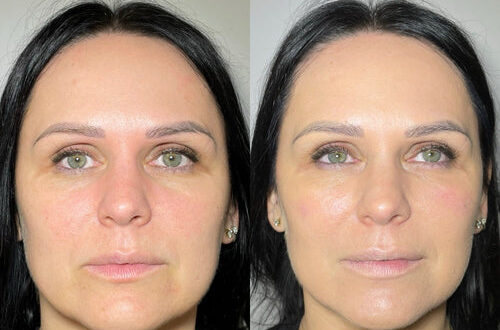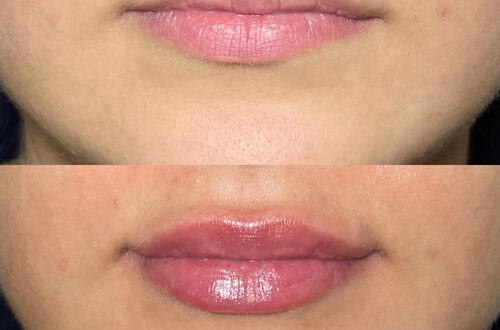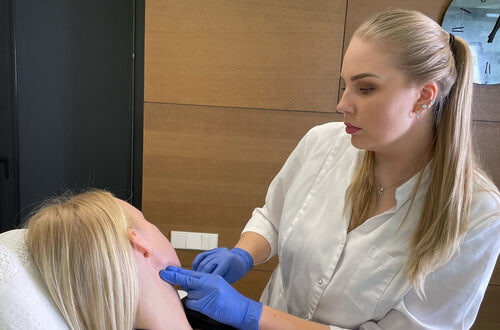Schedule a Dermal Filler Session with Dr. Laura Geige Now
Vitamin C’s Role
Schedule a Consultation for Dermal Fillers with Dr. Laura Geige Today
A Collagen Booster
Crepey skin, characterized by thin, wrinkled, and translucent skin, is often associated with a deficiency of Vitamin C. This essential nutrient plays a crucial role in collagen synthesis, a protein responsible for maintaining the skin’s elasticity and firmness.
Collagen fibers act like a scaffold, providing structural support to the skin and keeping it plump and resilient. As we age, our natural collagen production declines, leading to a loss of volume and increased wrinkles.
Vitamin C acts as a cofactor for enzymes involved in collagen synthesis. It is essential for the hydroxylation of proline and lysine, amino acids crucial for forming stable collagen molecules. Without sufficient Vitamin C, these enzymes cannot function properly, resulting in reduced collagen production and weakened skin structure.
Additionally, Vitamin C is a potent antioxidant that protects the skin from damage caused by free radicals. These unstable molecules can break down collagen and elastin fibers, accelerating skin aging. By neutralizing free radicals, Vitamin C helps preserve existing collagen and prevent further damage.
Incorporating foods rich in Vitamin C or taking supplements can help boost collagen production and improve the appearance of crepey skin. Citrus fruits, strawberries, bell peppers, broccoli, and kale are excellent sources of this vital nutrient.
Antioxidant Protection
Vitamin C plays a crucial role in maintaining healthy, youthful-looking skin. One of its most significant contributions is its potent antioxidant activity.
Antioxidants are compounds that protect our cells from damage caused by free radicals. Free radicals are unstable molecules produced during normal metabolic processes and exposure to environmental factors like pollution, UV radiation, and smoking.
These unstable molecules can wreak havoc on skin cells, leading to oxidative stress. This stress contributes to a breakdown of collagen and elastin, the proteins responsible for skin’s firmness and elasticity. As these fibers deteriorate, skin loses its resilience, becoming thinner, more prone to wrinkles, and appearing “crepey.”
Vitamin C, a powerful antioxidant, neutralizes free radicals, preventing them from harming skin cells and contributing to collagen and elastin damage. It also aids in the production of collagen, further supporting skin’s structural integrity.
Studies have shown that topical application of vitamin C can improve skin elasticity, reduce wrinkles, and promote a more even complexion.
Therefore, a deficiency in Vitamin C can contribute to the appearance of crepey skin due to its impact on collagen synthesis and antioxidant protection against free radical damage.
Other Nutritional Considerations
Hyaluronic Acid for Hydration
While Vitamin C deficiency can contribute to collagen depletion and lead to crepey skin, it’s essential to recognize that nutrition plays a multifaceted role in skin health.
Beyond vitamins, consider these nutritional factors:
Protein: A building block for collagen, the protein responsible for skin elasticity. Aim for lean sources like fish, poultry, beans, and lentils.
Healthy Fats: Essential fatty acids, found in oily fish, nuts, seeds, and avocados, support skin barrier function and hydration.
Zinc: Plays a role in wound healing and collagen synthesis. Good sources include oysters, beef, pumpkin seeds, and chickpeas.

Antioxidants: Protect against free radical damage that can degrade collagen. Load up on colorful fruits and vegetables like berries, leafy greens, and tomatoes.
**Hyaluronic Acid:** This naturally occurring substance in the skin acts as a humectant, attracting and retaining moisture. While not directly addressing vitamin deficiencies, it can significantly improve hydration and plumpness, reducing the appearance of crepey skin.
Consider supplementing with hyaluronic acid or incorporating foods rich in this compound, such as bone broth, leafy greens, and beets.
It’s important to note that addressing crepey skin requires a holistic approach. Nutritional changes should be combined with a consistent skincare routine, sun protection, and adequate hydration.
Zinc: The Skin Healer
While various factors contribute to crepey skin, including aging and sun exposure, one often overlooked nutritional consideration is zinc deficiency.
Zinc plays a crucial role in collagen synthesis, a protein essential for maintaining skin’s elasticity and firmness. When zinc levels are low, collagen production decreases, leading to thinner, more fragile skin that appears wrinkled and crepey.
Here’s how zinc supports skin health:
- Collagen Synthesis: Zinc is a cofactor for enzymes involved in collagen production.
- Wound Healing: Zinc aids in tissue repair and regeneration, essential for addressing any micro-tears or damage that contribute to crepey skin.
- Cell Turnover: Zinc promotes healthy cell turnover, ensuring the skin sheds old cells efficiently and replaces them with new ones, contributing to a smoother texture.
- Protection Against Sun Damage: Some research suggests zinc may help protect against UV-induced damage, reducing further breakdown of collagen and elastin.
If you suspect you might have a zinc deficiency, it’s essential to consult with a healthcare professional. They can assess your individual needs through blood tests and recommend appropriate supplementation if necessary.
Remember that while supplementing with zinc can be beneficial, it should not replace a balanced diet rich in zinc-containing foods such as:
- Oysters
- Red meat
- Poultry
- Beans and lentils
- Nuts and seeds
- Whole grains
By addressing any potential zinc deficiencies and incorporating these foods into your diet, you can support skin health and potentially improve the appearance of crepey skin.
Lifestyle Factors
Sun Exposure & Damage
Crepey skin, characterized by its thin, wrinkled appearance, often stems from a combination of factors including aging, sun damage, and nutritional deficiencies.
While multiple vitamins play a role in maintaining healthy skin, vitamin C deficiency is strongly linked to crepey skin.
Vitamin C is essential for collagen synthesis, the protein that provides structure and elasticity to the skin. Insufficient vitamin C levels can impair collagen production, leading to weakened skin fibers and a loss of firmness, resulting in that characteristic crepey texture.
Lifestyle factors significantly influence both vitamin C levels and sun exposure, which contribute to skin damage.
A diet lacking in vitamin C-rich foods like citrus fruits, berries, tomatoes, and leafy greens can lead to deficiency. Conversely, a diet abundant in these foods supports adequate vitamin C intake.
Sun exposure is another major culprit behind crepey skin. Ultraviolet (UV) radiation damages collagen and elastin fibers, accelerating skin aging and contributing to the development of wrinkles and thinning.
Excessive sun exposure can deplete vitamin C stores in the skin, further exacerbating its effects.
Protecting yourself from the sun is crucial for preventing further damage. Wearing protective clothing, seeking shade during peak hours, and using broad-spectrum sunscreen with an SPF of 30 or higher are essential preventive measures.
In addition to dietary adjustments and sun protection, incorporating other lifestyle modifications can support healthy skin and minimize crepey appearance. A balanced diet rich in antioxidants, sufficient hydration, quitting smoking, managing stress, and getting enough sleep all contribute to overall skin health.
Smoking and its Impact
Crepey skin, characterized by loose, wrinkled skin with a thin and papery texture, can be influenced by a multitude of factors. While vitamin deficiencies can play a role, it’s important to understand that lifestyle choices and environmental factors often have a more significant impact.
**Smoking**, in particular, is a major contributor to crepey skin. Tobacco smoke contains harmful chemicals that damage collagen and elastin fibers, the proteins responsible for skin’s strength, elasticity, and firmness.
When these fibers are damaged, the skin loses its ability to bounce back, leading to wrinkles, sagging, and a crepe-like appearance. Smoking also restricts blood flow to the skin, depriving it of essential nutrients and oxygen necessary for healthy cell regeneration.
Get Started with Your Dermal Filler Consultation with Dr. Laura Geige
Furthermore, smoking accelerates the aging process by increasing oxidative stress, which damages cells and contributes to collagen breakdown.
Beyond smoking, other **lifestyle factors** can also influence skin elasticity:
* **Sun exposure:** UV radiation from the sun breaks down collagen and elastin fibers, leading to premature aging.
* **Diet:** A diet lacking in fruits, vegetables, and essential fatty acids can deprive the skin of vital nutrients needed for healthy cell function.
*Hydration**: Dehydrated skin appears dull, wrinkled, and more prone to creping.
* **Sleep deprivation:** Lack of sleep can lead to increased cortisol levels, a stress hormone that damages collagen and contributes to premature aging.
While addressing vitamin deficiencies is important for overall health, it’s crucial to recognize the significant impact lifestyle choices have on skin elasticity and the development of crepey skin.
The Lady London Cycle for Azaylia Pinnacle Wellbeing Media The New Cinema Magazine
- Duke Dennis: Age, Career, and Social Media Success - May 8, 2025
- What Vitamin Is Lacking For Crepey Skin? - December 21, 2024


